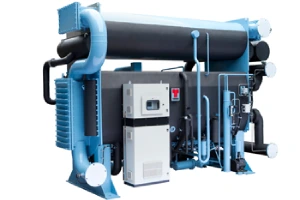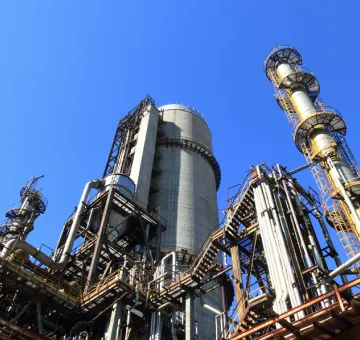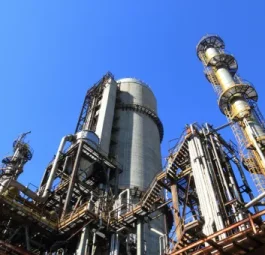Hot Water Operated Absorption Chiller
The efficiency of this absorption chiller provides sustainable cooling solutions by utilizing waste heat to reduce energy consumption and environmental impact.

Introducing Hot-Water Operated Absorption Chillers
Hot-water operated absorption chillers provide an efficient and environmentally friendly solution for meeting business cooling needs by utilizing waste heat rather than relying solely on electricity. Designed for facilities that produce surplus heat, these chillers effectively convert that energy into cooling, resulting in reduced overall energy costs. With fewer moving parts and a strong emphasis on sustainability, they represent a prudent choice for organizations aiming to lower their environmental impact while ensuring consistent and reliable cooling.
What Makes Hot-Water Operated Absorption Chillers Unique?
Hot-water operated absorption chillers stand out by using waste heat for cooling, unlike conventional electric chillers that rely solely on electricity. This approach enhances energy efficiency and reduces operational costs. With fewer moving parts, these chillers require less maintenance and offer improved reliability. They also excel in high-temperature environments, making them suitable for facilities with surplus heat. Their versatility allows them to adapt to various applications, making them a sustainable and efficient cooling solution.
How Do Hot-Water Operated Absorption Chillers Work?
Hot-water-operated absorption chillers offer an innovative approach to cooling by leveraging waste heat. The process begins with a heat source, often from industrial operations or boilers, which heats water to evaporate the refrigerant, typically ammonia. This refrigerant absorbs heat from the environment, creating a cooling effect.
The vapor then moves to the absorber, where it combines with an absorbent like water, releasing heat removed by cooling water. This mixture is pumped to the generator, where additional heat separates the refrigerant from the absorbent, allowing the cycle to continue. This effective process maximizes energy use and reduces operational costs, making these chillers a sustainable choice for cooling needs.
Key Benefits of Hot-Water Operated Absorption Chillers
Hot-water-operated absorption chillers offer several advantages that make them a preferred choice for various cooling applications. While there are many benefits, this section focuses on the key features that set these chillers apart.
- Reduces electricity consumption by utilizing waste heat.
- Minimizes greenhouse gas emissions through waste heat repurposing.
- Requires less upkeep due to fewer moving parts.
- Suitable for diverse applications, from industrial to commercial.
- Effective in environments with surplus heat.
Types of Hot Water Operated Absorption Chillers
Hot-water operated absorption chillers come in various types, each designed to meet distinct cooling needs and operational conditions. Knowing the differences among these types is essential for businesses to choose the chiller that best fits their specific requirements.

Single-Effect Absorption Chillers
Single-effect absorption chillers work using a straightforward absorption cycle, featuring a single stage for cooling. Typically employing water as the absorbent and ammonia as the refrigerant, they are simpler and more cost-effective than multi-effect systems. These chillers are well-suited for smaller applications, such as small commercial buildings or hotels, where minimizing initial investment is crucial.
Double-Effect Absorption Chillers
Double-effect absorption chillers take efficiency to the next level by incorporating two absorption cycles. This design enables them to deliver greater cooling output with less energy consumption compared to single-effect models. They are particularly advantageous for larger facilities that require significant cooling capacity, like industrial plants or large commercial spaces. The enhanced efficiency translates to lower operating costs, making them an appealing option for organizations prioritizing sustainability.


Triple-Effect Absorption Chillers
Triple-effect absorption chillers utilize three absorption cycles to achieve maximum efficiency and cooling capacity. Although they entail higher initial costs and complexity, they are particularly beneficial for large-scale industrial applications. By significantly reducing energy consumption, these chillers become attractive for businesses that generate substantial waste heat. The potential for long-term energy savings often justifies the initial investment, enhancing overall operational efficiency.
Best Facilities for Hot-Water Operated Absorption Chillers
Hot-water operated absorption chillers are particularly beneficial in facilities where waste heat is generated or where energy efficiency is a priority. Here are four key facilities where these chillers are essential:

Industrial Manufacturing Plants
In industrial manufacturing plants, significant amounts of waste heat are produced during processes such as machining, molding, or chemical production. Hot-water operated absorption chillers can effectively utilize this surplus heat to provide cooling for production areas, ensuring optimal temperatures for machinery and products. This not only enhances operational efficiency but also reduces energy costs by repurposing waste heat rather than relying solely on electricity for cooling.
Hospitals and Healthcare Facilities
Hospitals and healthcare facilities require reliable cooling systems to maintain controlled environments for patient care, surgical procedures, and medical equipment. Hot-water absorption chillers are ideal for these settings, as they can integrate seamlessly with existing heating systems, such as hot water boilers. Additionally, their efficiency helps lower operational costs, which is crucial for healthcare institutions that need to allocate budgets effectively while ensuring patient comfort and safety.


Commercial Buildings and Hotels
In commercial buildings and hotels, maintaining comfortable indoor temperatures is vital for occupant satisfaction. Hot-water-operated absorption chillers can be used to leverage waste heat from boilers or cogeneration systems, providing an energy-efficient cooling solution. By utilizing waste heat for cooling, these chillers help reduce electricity costs while delivering reliable temperature control in guest rooms, conference areas, and common spaces.
Food Processing Facilities
Food processing facilities generate significant heat during cooking, pasteurization, and other processes. Hot-water absorption chillers can effectively harness this waste heat to cool storage areas, packaging lines, and production spaces. By maintaining optimal temperatures, these chillers help ensure food safety and quality while also reducing energy consumption, making them a smart choice for businesses in the food industry aiming for sustainability and efficiency.

Navigating Challenges and Solutions for Hot-Water Operated Absorption Chillers
Hot-water-operated absorption chillers offer significant advantages, but they also come with challenges. Recognizing these obstacles and implementing effective solutions is crucial for optimizing performance and ensuring reliable operation.
Dependency on Heat Source
Hot-water absorption chillers depend on a consistent supply of high-quality hot water for effective cooling. Fluctuations in heat availability can lead to inefficiencies and reduced cooling capacity. To mitigate this, facilities should invest in reliable heat generation systems, such as boilers or waste heat recovery units. Implementing monitoring tools can help maintain a stable heat supply, enhancing operational efficiency.
Complex Integration
Integrating hot-water absorption chillers into existing HVAC systems can be complex and may require specialized expertise. Engaging skilled HVAC professionals during installation is essential for streamlining this process. Proper planning and collaboration ensure correct system configuration, minimizing the risk of operational disruptions.
Importance of Maintenance
Regular maintenance is vital for sustaining the efficiency and reliability of hot-water absorption chillers. Neglecting routine inspections can lead to decreased performance and higher operational costs. Establishing a proactive maintenance schedule with trained technicians ensures timely checks and repairs, maximizing the benefits of the chillers while minimizing downtime.
Performance Variability
Hot-water absorption chillers can experience variability in performance due to changes in operating conditions and load demands. To address this, facilities should implement advanced monitoring systems that provide real-time data on performance metrics. Analyzing this data enables operators to make proactive adjustments, ensuring efficient operation across varying loads and conditions.
Collaborate with Experts for Customized Hot-Water Operated Absorption Solutions
Selecting the right expert for hot-water operated absorption solutions is crucial for success. Look for professionals with extensive experience, industry knowledge, and a proven track record in customizing systems to meet specific operational needs. Assessing their previous projects and client feedback can help ensure effective collaboration and optimal system integration.
Tritech is a leader in providing customized hot-water-operated absorption solutions. With a team of skilled engineers and a strong commitment to understanding each client’s unique requirements, Tritech delivers tailored solutions that enhance energy efficiency and operational reliability. Choosing Tritech means partnering with experts dedicated to optimizing cooling performance for your facility.
Looking for a hot water-operated chiller? Tritech has the solution. Reach out now!
Related Brands





FAQs
Hot-water-operated absorption chillers are those that use hot water as an energy source to produce chilled water. They are efficient and eco-friendly, often utilizing waste heat for cooling needs.
These chillers work using a refrigeration cycle that involves an absorbent solution and refrigerant. Hot water heats the absorbent, which then absorbs the refrigerant, creating a cooling effect as it evaporates.
Using hot-water-operated absorption chillers key benefits include energy efficiency, reduced operational costs, lower environmental impact, and the ability to utilize waste heat. They also have fewer moving parts, resulting in lower maintenance needs.
Hot-water absorption chillers are typically used in various industries. These chillers are ideal for industrial plants, commercial buildings, hospitals, and facilities with surplus heat sources, such as waste heat recovery systems.
Selecting the right chiller involves assessing your cooling needs, available heat sources, and integration capabilities with existing systems. Consulting with HVAC experts can help you make an informed decision.
Regular maintenance includes routine inspections, cleaning, and monitoring of system performance to ensure optimal operation. Establishing a proactive maintenance schedule with trained technicians is essential.
Yes, these chillers can be integrated into existing HVAC setups, but it may require specialized expertise. Collaborating with skilled HVAC professionals can help ensure a seamless integration process.
Contact Our HVAC-R Experts
With experts and sales engineers throughout the country, we're ready to talk, anytime. · How can we help you today?




